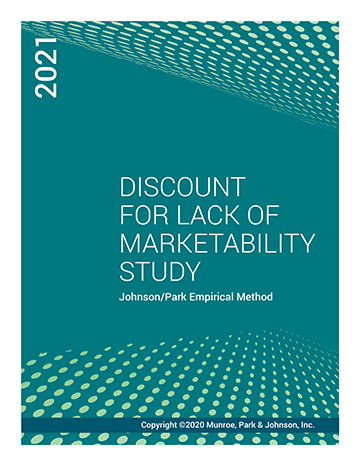2021 Discount for Lack of Marketability Study
September 2021 PDF
Bruce A. Johnson, James R. Park
Johnson/Park
The 2021 Discount for Lack of Marketability Study provides objective rate of return measures to implement the Johnson/Park Empirical Method for determining a discount for lack of marketability (DLOM) for the valuation of interests in privately held corporations and partnerships. This report instantly provides you with the most current DLOM rate of return information including a thorough explanation and example on how to apply this data. This methodology has been used in several tax court cases including the first family limited partnership (FLP) case to go to trial.
Practitioners often apply a fixed discount for lack of marketability without regard to the resulting effect on the rate of return. This practice is inconsistent with the fundamental concept of valuation which compares risk to reward. To determine the size of the discount, the three rate of return studies in this report can be used to measure the increase in return required to compensate investors for the lack of marketability of your subject interest. Based on the BVR DLOM Survey, the Johnson/Park Empirical Method the Johnson/Park Empirical Method is one of the most popular methods used to determine DLOMs by BV appraisers. Order today and receive the complete report to support your DLOM analysis.
NEW FOR 2021:
The 2021 Study is new and what is most important is that it is consistent with prior year findings. Appraisers now have data to compare from 2006, 2011 and 2014-2021. All these annual studies show that investors demanded an 30%-45% higher rate of return for the additional risk of longer holding periods. This study allows appraisers to quote the most recent data available.
Of note, the premiums did increase compared to the most recent studies as equity markets improved to all-time highs.
- Introduction
- Private Equity vs. Public Equity Returns
- Restricted Stock Returns
- Long Term vs. Short Term Bond Horizons
- Summary
- Application
- Conclusion
